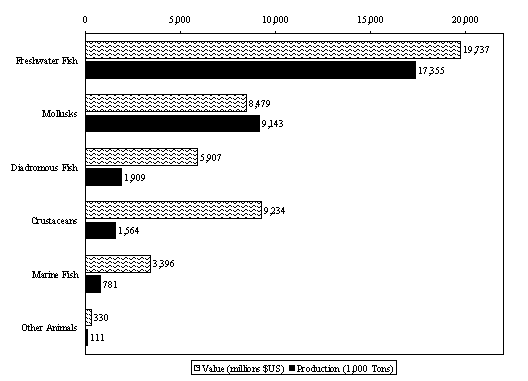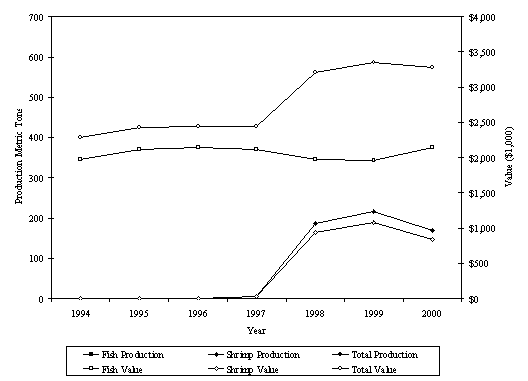
Introduction
The efficient utilization of resources, be it man power, fertilizer, water or even light and heat, has long been the aim of agriculture. Countless agricultural methods have been developed and perfected over the years to maximize production. Innovations such as greenhouses and genetic engineering have enabled agriculture to be successful even in areas where it might not otherwise be possible.
Prior to the widespread use of commercial farming, the integration of various aspects of farm production was commonplace (Fernando and Halwart 2000). Today, as consumers and producers alike become more environmentally conscience, we are seeing a renewed interest in more efficient and better utilization of resources. By integrating aquaculture production into traditional agriculture, the impact of farming on already limited water resources (Prinsloo and Schoonbee 1993; Ingram et al. 2000) and the reliance on chemical fertilizers can be reduced (Fernando and Halwart 2000).
Various methods have been proposed over the years to merge the farming of aquatic animals with field crops and/or terrestrial animals (Prinsloo and Schoonbee 1987; Ruddle and Zhong 1988; Fernando and Halwart 2000). To date, much effort has gone into small-scale (subsistence level) sustainable production of plants and animals (Lightfoot et al. 1993; Gupta et al. 1997), with one common approach being the use of agriculture wastes (manures and plant wastes for example) as a fertilizer for fish ponds, effectively converting unusable proteins into a usable commodity (Prinsloo and Schoonbee 1987; Prinsloo and Schoonbee 1993). More recently, similar ideas are being applied on a larger scale, where alternative protein sources are being explored as a component in aquaculture feeds. Traditionally, fish feeds required large amounts of fishmeal as the primary source of protein (Debault et al. 2000). In catfish feeds, for example, soybean meals commonly replace 45% of the fishmeal in the diet formulation (Lim et al. 1998). Other alternative proteins are also being explored, including canola meal (Lim et al. 1998), corn gluten meal (Kikuchi 1999), lupin meal (Sudaryono et al. 1999), soybean/poultry meal (DeBault et al. 2000) and blood meal (Johnson and Summerfelt 2000).
As aquaculture faces continued pressure from the environmental community and increased governmental regulations, efforts are being made to further improve production efficiency and decrease the environmental impacts of the industry. In the United States, perhaps the most important environmental concern facing the aquaculture industry is the disposal of the nutrient rich effluent water produced during the culture of aquatic animals (Goldburg and Triplett 1997). Great steps have already been taken toward reducing the impact that these effluent waters have by reducing nutrient loading through the manipulation of feeds and feeding practices (Ketola and Harland 1993; Cho and Bureau 1997), improved water treatment enabling water reuse (Rosati and Respicio 1999; Jones et al. 2001; Kinne et al. 2001) and reducing the volume of water used in animal production (Hopkins et al. 1993). While each of these methods can effectively reduce the impact that aquacultural effluents will have on the receiving water, they do not eliminate aquaculture effluents entirely.
In freshwater systems, these nutrient rich effluents can and are being used to irrigate any number of crops (Prinsloo and Schoonbee 1987). However, freshwater fish account for 41.9% of world aquaculture production by value and 56.2% of the total production by weight (FAO 2000). The remainder of world aquaculture production is attributed to marine organisms, including fish, mollusks and crustaceans, with farmed shrimp accounting for only 5.1% of the total aquaculture production by weight in 1998 but 19.6% of the total value (Fig. 1). Disposal of waste water from the production of marine organisms is not so straight forward, as the salinity of the water prohibits its use as a source of irrigation water, except in select cases. Saline effluents have been used successfully to irrigate halophytes (Brown and Glenn 1999; Brown et al. 1999), although commercial scale production of these crops is limited (Glenn et al. 1991; Glenn et al. 1998). While low-salinity waters have been used successfully to grow numerous marine species including; red drum, Sciaenops ocellatus (Fosberg et al. 1996; Fosberg and Neill 1997), white shrimp, Litopenaeus vannamei (Samocha et al. 1998) and tiger prawns, Penaeus monodon (Cawthorne et al. 1983; Flaherty and Vandergeest 1998), integration with agriculture has been limited to the addition of manures to increase pond productivity and the secondary culture of seaweeds (De La Cruz 1994).
Figure 1. 1998 world aquaculture production and value (FAO 2000).

Recent expansion of the aquaculture industry in Arizona has enabled us to study the integration of olive groves with marine shrimp culture. There are currently four aquaculture facilities in the state growing the pacific white shrimp, L. vannamei. As of 1999, production of marine shrimp was close to 100 metric tons, with a farm gate value of over one million dollars (Fig. 2) (Toba and Chew 2001). Each of these farms is using brackish (1.3-5.0 ppt) groundwater and in many instances, effluent generated at these farms is being used to irrigate field crops including wheat, sorghum, cotton, alfalfa and olives. The major objective in undertaking the current study was to quantify the effects of irrigating olive trees with low-salinity shrimp farm effluent.
Figure 2. Quantity and value of aquaculture products grown in Arizona between 1984 and 2000 (Toba and Chew 2001).
